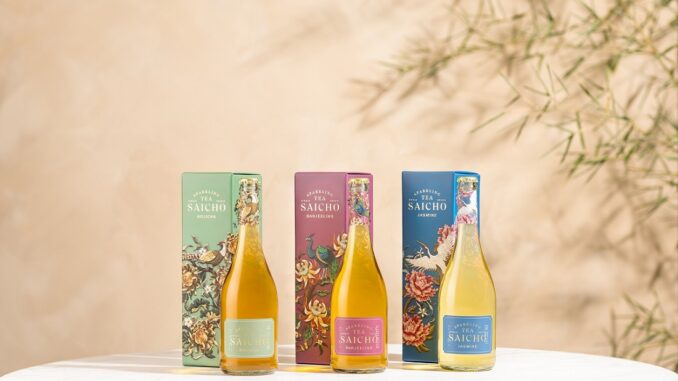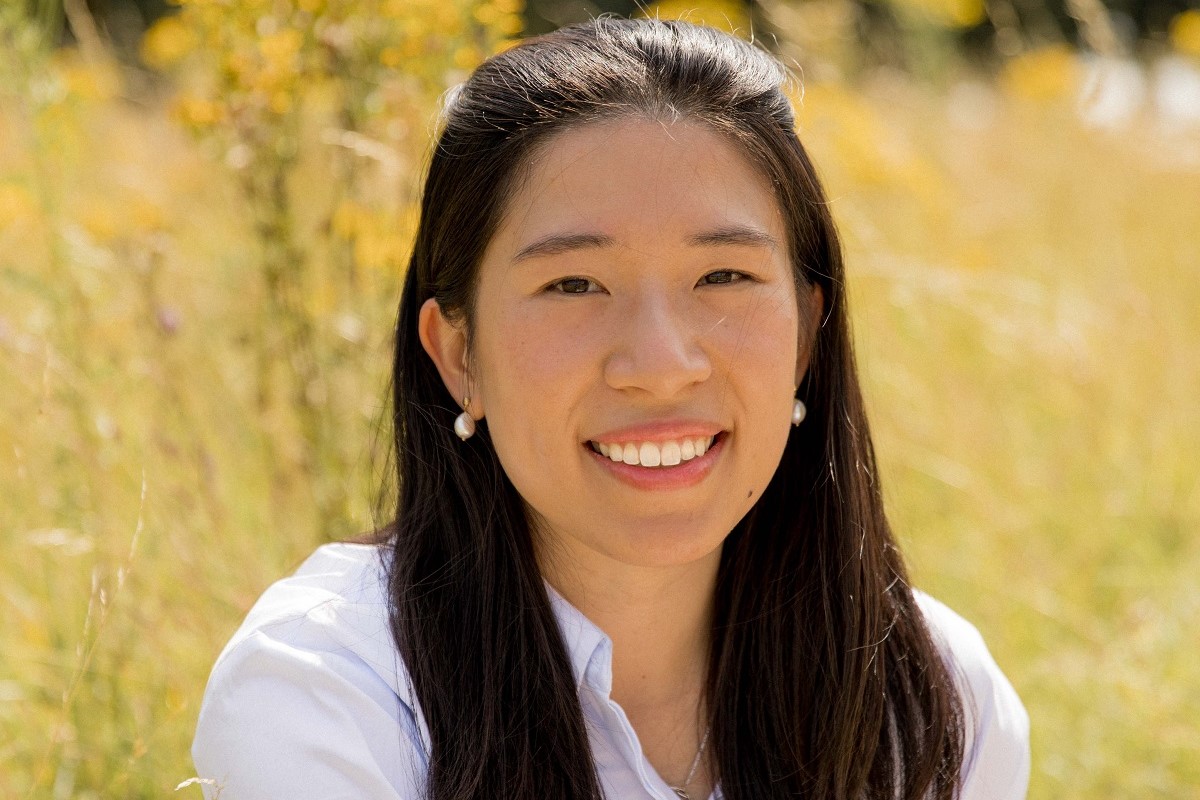
Lovina Uittenbroek and Natalie Winkworth-Smith are modern tea pioneers. They are continuing the UK’s tea heritage in fragrant, healthy and sparkling forms.
Natalie, nee Xiao Nan Natalie Chiu, likes to drink tea from a flute.
The Nottingham University graduate has released Saicho Eight Immortals, the latest addition to her range of limited edition, gourmet, no-alcohol sparkling teas. She is the UK’s only commercial sparkling tea maker.
The new Champagne-like tea features Oolong tea, grown 1000 metres above sea-level in Tian Liao village on Phoenix Mountain in Guangdong province. The foggy climate, mineral-rich soil, the decades-old towering trees on which they grow, as well as the painstaking harvesting and wilting process apparently lend the tea its unparalleled flavour complexity.
Natalie, who is alcohol-intolerant and wanted to create a luxury drink for fine dining pairing, says:
“Every step is meticulously overseen by a qualified tea master to ensure this world-famous tea maintains its unmistakable fragrance and complexity.”
UK-based Saicho’s three signature flavours – Darjeeling, Hojicha (made with roasted Sencha green tea) and Jasmine (Fujian province green tea) – are also available from Saicho’s website and select stockists. They are already served at The Dorchester, Darjeeling, Portman Square’s Nobel Hotel and Victoria’s Lorne restaurants.
Katie Exton, sommelier and co-founder of Lorne Restaurant, says:
“Saicho is so food friendly. It works well with charcuterie, and lovely with chicken tagine. It also tastes great with lasagne. Every time the drink was refreshing and delicate enough not to clash with any of the ingredients or flavours from the food and had these lovely peach and orange fruity notes but with a refreshing not savoury but also not sweet finish. It also worked with chocolate, where it tasted quite malty and caramelly.”
Saicho is a single origin, cold brew sparkling tea brand, carbonated after it’s been brewed. It’s not fermented. So, it’s not a kombucha.
But its Far Eastern roots are key. Natalie adds:
“It’s the product of my exposure to two well-established tea cultures and not being able to drink alcohol.
“Having been born and raised in Hong Kong, I’ve always been fascinated with the versatility and variety of tea. So, when I met my husband Charlie when we were both doing our PhDs in Food Science, we began cooking up the idea for a sparkling tea that creates a new dimension to food pairing without alcohol, whether it be eating in a fine dining restaurant, enjoying a drink at a wine bar or at home.”
Charlie comments:
“Wine lovers know that with wine, provenance matters – where it is grown, the time of harvest, even the people who make it. Tea has a similarly rich development process. It matters what time of year it is harvested, or the altitude that it comes from. It has the history and romance of wine, along with bitterness and astringency so it can make a great companion to food.”
Saicho is named after a Buddhist monk. The Eight Immortals celebrates a Daoist parable.
In 805, the monk Saicho returned to Japan from a Buddhist retreat in Tang China. With him he brought, not only, the knowledge of a strange and exotic drink that the Chinese monks would use to prolong and enhance their lengthy meditation sessions but also the source of this mysterious drink – tea seeds.
Armed with this key meditational aid, Saicho founded the Tendai school of Buddhism. The Emperor Saga, on a visit to Saicho’s Sofukufi temple had one taste and loved it so much he immediately ordered tea trees to be planted in provinces all over Japan.

An ancient, much neglected tea is being cultivated in west Hampstead, north London.
Lovina Uittenbroek was born and spent eight years in Kobe, Japan. Her parents are from Mumbai. She makes buckwheat tea.
“There is a small Indian community in the famous port. My parents moved there in the 80s and my Dad set up his own business as a textile exporter. I have grown up eating Japanese food and drinking Japanese tea.”
There is also a huge ‘soba’ (buckwheat noodle) culture in Japan and Lovia first tasted buckthorn tea in a noodle restaurant. Moving to London where she studied Business Management at King’s College, London, her mother sent her special care packages including her favourite buckwheat tea. She couldn’t find it anywhere.
“It was over my maternity leave (over lockdown in 2021), when I was sharing a pot of soba-cha with my husband after dinner, when I had the idea of creating my own brand to make this tea more accessible in the UK. I’ve always wanted to set up my own business.”
An Osaka tea producer recommended finding a supplier in China.
“I always thought buckwheat tea was Japanese! The sub-tropical climate in the mountainous regions of China provides best for the growth of ‘tartary’ buckwheat from which my T. is made.”
Lovina sampled around thirty different types of buckwheat tea to find the one closest to the one she loved in Japan. The tea, now sold on Amazon and in Selfridges, comes from the Sichuan province.
“Th T. started off as a placeholder ‘logo’ on my packaging that I thought looked nice, and simple – and then it evolved into my URL and Instagram handle. People even say to me ‘I had a cup of T.!
“My official (non-trading) company name is KSLD Limited (which you’ll find on the back of the pack at the bottom) – which stands for Kira, Sana, Lovina, Derek – the names of my family.”
Lovina started her career at a financial software company FactSet (a rival of Bloomberg), as an account manager. Then moved on to a fashion software start-up called EDITED, as head of sales development. Then she co-founded the Ignite Growth marketing agency with her husband.
Because the tea has been roasted, buckwheat tea has a subtly nutty flavour, with a smooth, rich, and slightly sweet aftertaste.
“If you like genmaicha (roasted rice tea), it has a similar feel to it, except it is more delicate, subtle and smooth.”
Some have likened buckwheat tea to ‘liquid peanut butter,’ ‘hot chocolate, and malty drinks like ‘Ovaltine’.
“A lot of ‘calming’ teas nowadays are blends that are enhanced with vitamins/adaptogens, whereas with buckwheat tea, you get natural goodness in a cup!
“It helps with digestion, as it contains insoluble fibre – many of my customers have said it’s helped reduce their bloating and IBS symptoms.”
Good for weight-loss – it’s sugar-free, and low in calories – the GI carbohydrate is an excellent addition to your diet if you’re trying to lose weight. And you can have added fibre by using the leftover buckwheat in your smoothie or breakfast bowl. Magnesium helps relaxation and the amino acid tryptophan helps release ‘feel-good’ serotonin. It is also caffeine and gluten-free.
Author Bio:
Kevin Pilley is a former professional cricketer and chief staff writer of PUNCH magazine. His humour, travel, food and drink work appears worldwide and he has been published in over 800 titles.
Photographs courtesy Saicho Drinks



Be the first to comment